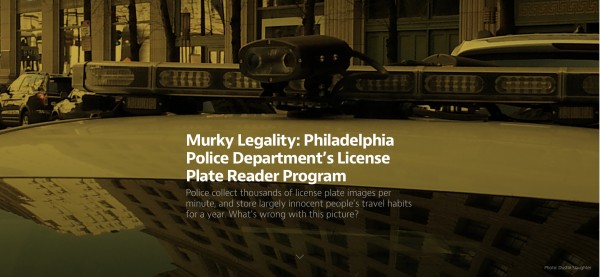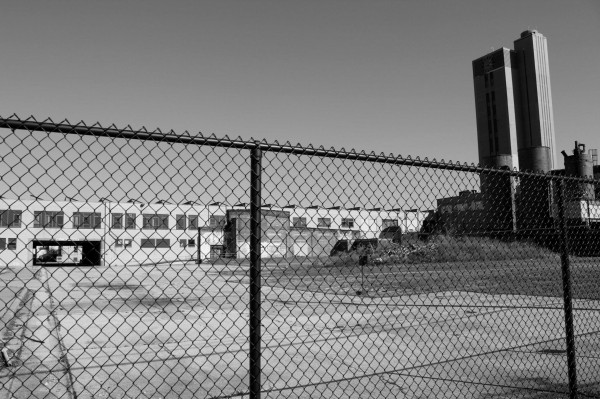![]() BY DUSTIN M. SLAUGHTER The Philadelphia Police Department is using Automatic License Plate Readers (ALPR), which enable patrol car mounted and stationary pole cameras to collect images of over 1,800 license plates per minute over a 24/7 period. This information is then stored on servers located inside Philadelphia’s Real Time Crime Center (RTCC) and Philadelphia’s fusion center, the Delaware Valley Intelligence Center (DVIC).
BY DUSTIN M. SLAUGHTER The Philadelphia Police Department is using Automatic License Plate Readers (ALPR), which enable patrol car mounted and stationary pole cameras to collect images of over 1,800 license plates per minute over a 24/7 period. This information is then stored on servers located inside Philadelphia’s Real Time Crime Center (RTCC) and Philadelphia’s fusion center, the Delaware Valley Intelligence Center (DVIC).
The department had 10 license plate readers in deployment as of 2011, according to police commissioner Charles Ramsey, although with new rounds of Homeland Security grant funding through the Urban Area Security Initiative, the number of units in use has likely increased. Various law enforcement agencies have not responded to repeated requests for comment on numerous points made in this article.
The Commissioner’s Directive
The 15-page “Directive 141“, issued by police Commissioner Charles Ramsey in 2013 and obtained through a Right-to-Know request filed by journalist Christopher Moraff, reveals previously unknown details about the police department’s use of the powerful license plate reader technology, including how collected plate data is handled and the length of time it can be stored by police.
ALPR technology enables the department to collect and store, without a warrant, the daily activities of average Philadelphians, the vast majority of whom are not under investigation. According to the directive, data not used for criminal investigations is stored on the Real Time Crime Center’s ALPR server for up to a year; data utilized for criminal investigations can be stored “indefinitely”. Information on the travel habits of people not under investigation can be queried by law enforcement personnel versed in the equipment’s use, allowing authorities to draw up a mosaic of innocent people’s daily lives, such as whose homes we visit at night, how many times we go to the drug store, trips to Planned Parenthood, visits to a psychologist’s office, and other activities that people take for granted as being private and privileged information.
The document also reveals another ALPR program managed by a little-known police group called the Southeastern Pennsylvania Regional Task Force (SEPA-RTF). The task force stores data uploaded from five state regions comprising 31 police departments, including Philadelphia, on a server inside Philadelphia’s fusion center, located in the same Quartermaster Depot building as the RTCC. This program’s mission ostensibly differs from the RTCC, as it seeks to “reduce the threat of terrorism and to protect critical infrastructure and historic sites.”
Quartermaster Depot building, housing the Philadelphia Police Department’s Real Time Crime Center and fusion center. Photo: Dustin Slaughter
Privileged Information, Easily Accessed
It’s not just ALPR-trained officers who have access, however. The ease with which any investigator can access an individual’s travel habits and gain a warrantless glimpse into one’s associates and other personally sensitive information is laid out in the document. All that is needed for an investigator to access this vast trove of information is a badge number, unit telephone number, unit or government email, and a stamp of approval from an RTCC supervisor, who is presumably given a legitimate-sounding reason for the inquiry. The directive also includes a statement outlining “proper” use of this vast trove of information:
The ALPR and associated data will ONLY be used as related to crime and official business.
It is unclear what “official business” actually means, but what is certain is that legally-ambiguous language like this clearly gives law enforcement personnel wide latitude in how data can be handled.
Blurred Jurisdictions and ‘Mission Creep’
The directive seems to indicate that the RTCC and fusion center have separate ALPR servers, although it is not clear to what degree the data is shared between databases, nor is it known to what degree agencies such as the FBI Joint Terrorism Task Force, Drug Enforcement Agency, and Department of Homeland Security, all of which staff the police department-managed Delaware Valley Intelligence Center, have access to the RTCC’s collection. However, as the fusion center functions in an “All Crimes, All Hazards” role, and the RTCC also assists in routine local criminal investigations, it is certainly within the realm of possibility that federal agencies may have access to certain data.
This shared role between the RTCC and fusion center, with its mix of local law enforcement and federal officials, further blurs the line between routine criminal investigations and terrorism-related investigations because it lowers the legal standard from the Fourth Amendment’s “probable cause” to a much murkier “reasonable suspicion”, a standard that is increasingly seeping from counter-terrorism operations into traditional policing as federal, state, and local law enforcement combine through information-sharing initiatives like fusion centers.
Questionable Efficacy
Law enforcement justifications for the use of LPRs are often exaggerated, as the overwhelming majority of crimes are nothing more than minor infractions that result in citations. Civil libertarians argue that the cost to individual privacy is too great to justify the wide scale use and lengthy data retention policies many departments?—?including the Philadelphia Police Department?—?employ in ALPR practices.
A 2013 ACLU report on license plate readers in 38 states highlights this fact. According to documents released from Maryland’s state fusion center in 2012, only 0.2 percent (1 in 500) of over 29 million license plate “reads” were “hits”, meaning plate numbers flagged on a database’s “hot list”. Of those hits, 97 percent were for a suspended/revoked registration or emissions violation?—?hardly the public safety threat posed by serious crimes.
Misread plates and database inaccuracies are also a problem, as a 2012 South Philly Review article points out:
About every 1,000 scans yields a stolen car whereas approximately every 6,000 scans produces an arrest, according to its manufacturer, but within minutes on their first day using the program last month, [two on-duty officers] yielded a hit, but it turned out the woman had purchased a repossessed vehicle and had not yet filed the necessary paperwork.
“She had to go through the inconvenience of us stopping her, having her confirm,” [Officer Robert] Veasey a 18th Street and West Moyamensing Avenue native, who now calls Roxborough home, said.
Since then, the local test subject has garnered only false hits.
As Criticism Grows, So Does Reform
Legal advocacy groups like the ACLU admit this powerful technology certainly has an important role to play in law enforcement, but oversight and transparency must go hand-in-hand with increased power wielded by police.
Some local politicians and law enforcement agencies at minimum recognize the need to have shortened data retention periods, particularly on individuals not under any suspicion. Minnesota State Patrol, for example, has a 48 hour window to hold on to license plate images before purging. The majority of states, townships, and cities retain this data from 35 days to one year, according to the ACLU.
ALPR policy reform, at times, has been spurred under unusual circumstances. In 2012, the Minneapolis Star Tribune, utilizing responses to public records requests, produced a map marking over 41 instances where Mayor R.T. Rybak’s car was photographed by ALPRs in 2011. The Star Tribune then published another ALPR story which pointed out that “of the 805,000 plate scans made in June, less than one percent were hits.” The mayor, alarmed, “directed the city’s chief of police to recommend a new policy on data retention.” State politicians soon began proposing legislation that would impose more restrictions on the use of this technology.
UPDATE: U.S. Circuit Court Of Appeals Rules Warrantless Cellphone Tracking Is Unconstitutional
ABOUT THE AUTHOR: Dustin M. Slaughter is a writer, photojournalist, agitator, and legal assistant. Interests: Criminal justice, surveillance state, political movements, more.


